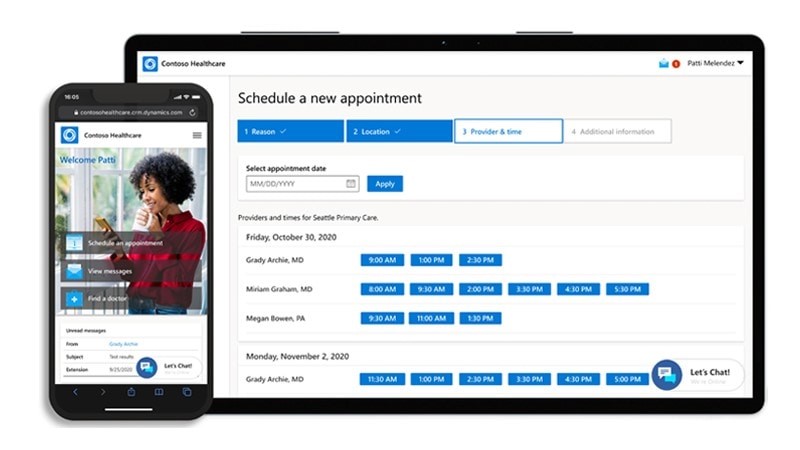
Reimagining the digital front door for healthcare
 Over the past year, my colleagues and I have seen a steady uptick in healthcare organizations requesting in-depth discussions on how to further develop their digital front door capabilites. One high-interest topic has been establishing a branded conversational bot (chatbot) that can facilitate frictionless experiences across all digital channels and throughout the engagement journey. Helping customers with the next steps in the process is dependent on the completeness of their digital strategy, their goals for patient experience and brand awareness and the organization’s maturity in integrating data and technology.
Over the past year, my colleagues and I have seen a steady uptick in healthcare organizations requesting in-depth discussions on how to further develop their digital front door capabilites. One high-interest topic has been establishing a branded conversational bot (chatbot) that can facilitate frictionless experiences across all digital channels and throughout the engagement journey. Helping customers with the next steps in the process is dependent on the completeness of their digital strategy, their goals for patient experience and brand awareness and the organization’s maturity in integrating data and technology.
Building conversational experiences in healthcare
If this is the organization’s initial foray into integrating chatbots, virtual assistants, or virtual agents into existing solutions, it might consider beginning with a simple informational chatbot that provides quick access to data in documents or FAQs. A solution like Microsoft QnA Maker can assist by creating a conversational question–and–answer layer over existing semi-structured content in just minutes. Informational chatbots can also service high–volume requests at the front end of digital assets. In 2020, many health organizations launched chatbots to assist consumers with COVID-19 assessments similar to those at the CDC, or with vaccine availability.
Advancing from information transfer, we find purpose-built chatbots that address top-of-mind requests, like “Find a doctor taking new patients,” “I need a pre-authorization,” or “What location is near me” (see Quest Diagnostics – chatbot at bottom right). These chatbots are best created from user experience design techniques, such as journey mapping and user personas. This upfront development work is key as consumers expect the chatbot experience to be highly efficient compared to alternatives like drilling down through app menus. An example of this thoughtful design process can be found in Cincinnati Children’s Hospital Medical Center’s Caren app. While kids are entertained with joke telling and a scavenger hunt, parents can receive digital parking passes and information on their child’s surgery status.
Oftentimes a health organization’s preferred use case requires a specialized service, like the Azure Heath Bot, with triage protocols, a built-in medical database, and natural language capabilities to understand clinical terminology. Purpose-built chatbots need to have the ability to securely integrate heath data from Fast Healthcare Interoperability Resources (FHIR) or electronic medical records (EMR) to drive engaging interaction. Combining health data with the chatbot can enable powerful queries, such as “What were the results of my last lipids test?” The real-time medical information that is returned eliminates shifting the consumer to a medical record application.
Beyond these core capabilities, consider infusing the chatbot with artificial intelligence (AI) that delivers cognitive skills that can be used to personalize and enrich the overall design. Two such services that can add an immediate benefit include real-time text translation to support equitable access for non-English speaking customers and sentiment analysis to sense the mood of the customer to ensure a smooth redirect to a human when consumers get frustrated.
Transforming the healthcare journey
Comprehensive digital front door projects frequently include multiple digital touchpoints, connect to a wide variety of data sources, and enhance the workflow of many business and clinical processes. Additionally, health organizations want to capture consumer preferences and take advantage of known care patterns. They also want to build intelligence into their activities and extend pertinent information through digital reach to customers.
Launched in October 2020, Microsoft Cloud for Healthcare provides trusted and integrated cloud capabilities to deliver better experiences, better insights, and better care for exactly this type of digital transformation. Microsoft Cloud for Healthcare enables digital front door scenarios by facilitating patient access to secure portals and mobile tools to help health consumers interact directly with health teams. Incorporating the strengths of Microsoft’s cloud services helps simplify routine tasks for better patient satisfaction and care transparency.
To gain a deeper understanding of how Microsoft Cloud for Healthcare can address your needs for a connected digital front door experience, please visit the Microsoft Cloud for Healthcare site and review the guided tours and videos for solutions like Personalized Care, Virtual Health, and Patient Insights.




